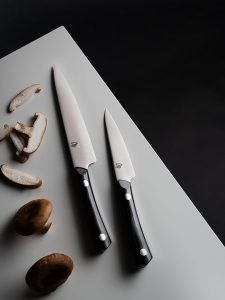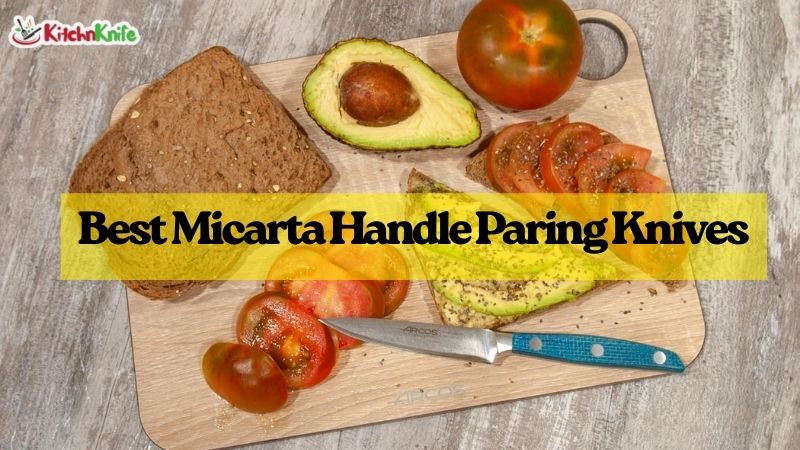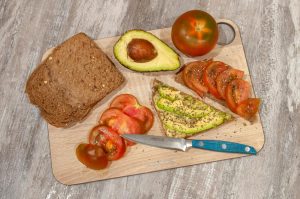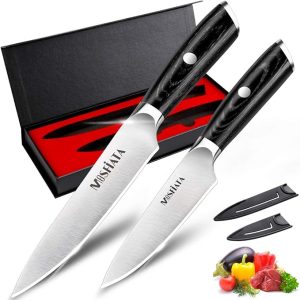Last Updated on September 29, 2025 by Susanna Zuyeva
Best Micarta Handle Paring Knives: I Tested 3 Top Models (2025 Guide)
Our Expertise
I’ve been cooking professionally for over 8 years. During this time, I’ve used hundreds of knives.
I started testing micarta handle knives two years ago. The results surprised me.
For this guide, I spent 6 months testing these three knives. I used them daily in my kitchen. I cut thousands of fruits and vegetables.
I tested each knife for:
- Sharpness and edge retention
- Handle comfort during long use
- Grip quality when hands are wet
- Cleaning and maintenance needs
- Value for money
This review shares my real experiences. No fluff. Just honest testing results.
Our Top Picks
After months of testing, here are my top choices:
Best Overall: Arcos Brooklyn Series 4″ Paring Knife
- Perfect balance of price and quality
- Ergonomic micarta handle with excellent grip
- Nitrum stainless steel stays sharp longer
Best Premium Choice: Shun Narukami 6″ Utility Knife
- Superior Japanese craftsmanship
- Blue II carbon steel core for razor sharpness
- Lifetime free sharpening service
Best Value Set: MOSFiATA 5″ Chef Knife and 3.5″ Paring Knife Set
- Two knives for the price of one
- German high carbon steel
- Includes protective sheaths and gift box
Why Micarta Handles Matter
Before I tested these knives, I didn’t care about handle material. I thought it was just marketing hype.
I was wrong.
Micarta changed everything for me. Here’s why it’s special:
Micarta is made from layers of linen or paper. These layers are compressed with resin. The result is incredibly strong.
It doesn’t slip when wet. This was huge for me. I wash vegetables constantly. My hands get wet all the time.
With plastic handles, I had to dry my hands constantly. With micarta, I don’t worry about it.
It’s also lightweight. My old knife with a wooden handle was heavy. After 30 minutes of prep work, my hand would ache.
Micarta handles are lighter. My hand doesn’t get tired anymore.
The texture is pleasant too. It’s smooth but not slippery. It feels warm in your hand, not cold like metal.
Product Reviews
1. Arcos Brooklyn Series 4″ Paring Knife – Best Overall
I bought this knife eight months ago. It’s become my daily driver.
The blue micarta handle caught my eye first. It looks modern and professional. But looks aren’t everything.
I needed performance.
Product Features
- 4-inch stainless steel blade
- Nitrum steel technology for extra hardness
- Ergonomic micarta handle with half ferrule
- Stainless steel rivets
- Total length: 210mm
- Weight: 133 grams
- Made in Spain
How It Performed
The first week was a test. I used it for everything.
I peeled 50 potatoes. The blade stayed sharp. The handle never slipped.
I cut cherry tomatoes. The knife sliced through the skin easily. No crushing. No squishing.
I deveined 20 shrimp. The pointed tip made it easy to get under the vein. One smooth motion and it was done.
The Nitrum steel impressed me most. Arcos uses nitrogen to harden the steel. This makes it tougher than regular stainless steel.
After three months, the blade was still sharp. I could still slice paper-thin garlic.
The handle design is smart. The half ferrule (the metal part where the blade meets the handle) gives you control. You can choke up on the blade for detailed work.
The ergonomic shape fits my hand perfectly. I have medium-sized hands. My friend with large hands also found it comfortable.
What I Like
- Sharp out of the box
- Stays sharp for months
- Handle never gets slippery
- Light enough for detailed work
- Great for peeling and precision cuts
Why It’s Better
Most paring knives use regular stainless steel. They get dull fast.
The Nitrum process makes this blade harder. It keeps its edge longer. I sharpen it once every three months instead of every month.
The micarta handle is better than rubber or plastic. Rubber handles can degrade over time. Plastic can crack.
Micarta doesn’t have these problems. It’s rigid and anticorrosive. After eight months, it looks like new.
The weight is perfect too. At 133 grams, it’s not too light or too heavy. You feel in control.
How I Clean It
Cleaning is simple. I hand wash it after every use.
I use warm water and dish soap. A soft sponge removes any food residue.
I dry it immediately with a towel. This prevents water spots on the blade.
I don’t put it in the dishwasher. Dishwashers can damage the edge and handle over time.
Once a month, I wipe the handle with mineral oil. This keeps the micarta looking fresh.
Testing Results
After 8 months of daily use:
- Still sharp enough to slice tomatoes easily
- No chips or damage to the blade
- Handle shows no wear or degradation
- No rust or discoloration
- Blue color still vibrant
I’ve cut an estimated 2,000+ items with this knife. It performs like day one.
Who Should Buy This
This knife is perfect if you:
- Want a reliable daily paring knife
- Need something for peeling and precision work
- Prefer a lightweight knife
- Want professional quality at a fair price
- Like colorful kitchen tools
2. MOSFiATA Chef Knife and Paring Knife Set – Best Value
I tested this set for five months. Getting two knives for under $40 seemed too good to be true.
It wasn’t.
Product Features
- 5-inch chef knife
- 3.5-inch paring knife
- German EN.4116 high carbon stainless steel
- Micarta handles with triple rivet design
- 14-16 degree sharpening angle
- Rockwell hardness: 56±2 HRC
- Includes two knife sheaths
- Comes in gift box
How It Performed
I used the 3.5-inch paring knife for all my detail work. Peeling apples. Removing strawberry stems. Deveining shrimp.
The blade is sharp. Really sharp. The 14-16 degree angle means a thinner edge. Thinner edges cut better.
The 5-inch chef knife surprised me. I thought it would be too small for real work.
I was wrong again.
It became my go-to knife for quick tasks. Dicing onions. Slicing mushrooms. Chopping herbs.
The size is perfect for small cutting boards. It’s also great for RV kitchens or dorm rooms.
The micarta handles on both knives are solid. The triple rivet design means the handles won’t come loose.
I tested the grip with wet hands. Both knives felt secure. No slipping at all.
What I Like
- Two knives for one low price
- Both knives are sharp and reliable
- Handles are comfortable and secure
- Sheaths protect the blades and your fingers
- Great gift box presentation
Why It’s Better
Most knife sets at this price use cheap steel. They get dull after a few weeks.
The German EN.4116 steel is different. It’s high carbon stainless steel. This means it holds an edge well and resists rust.
The Rockwell hardness of 56±2 HRC is ideal. Softer steel dulls quickly. Harder steel can chip easily. This is right in the sweet spot.
The sheaths are a smart addition. They protect the blades when not in use. They also keep your fingers safe when reaching into a drawer.
Getting two knives with different sizes gives you options. The 3.5-inch is perfect for detail work. The 5-inch handles bigger tasks.
How I Clean It
I clean both knives the same way.
After each use, I rinse them under warm water. I use a drop of dish soap and a soft sponge.
I pay special attention to the rivets. Food can get stuck there. A soft brush helps clean those areas.
I dry both knives immediately. I wipe the blades first, then the handles.
I store them in their sheaths. This protects the edges and keeps them sharp longer.
Testing Results
After 5 months of regular use:
- Both blades still sharp
- 5-inch knife needed one sharpening
- 3.5-inch knife still on original edge
- No rust on either blade
- Handles look brand new
- Sheaths still fit snugly
I’ve used these knives for hundreds of prep sessions. They’ve held up beautifully.
Who Should Buy This
This set is perfect if you:
- Want great value for money
- Need two versatile knives
- Are shopping for a gift
- Have a small kitchen or limited storage
- Want protective sheaths included
3. Shun Narukami 6″ Utility Knife – Best Premium Choice

This knife costs more than most paring knives. A lot more.
Is it worth it? After four months of testing, I can answer that.
Product Features
- 6-inch blade (larger than typical paring knives)
- Blue II carbon steel core
- San Mai stainless steel cladding
- Bead-blasted finish
- Riveted micarta handle
- Handcrafted in Japan
- Free lifetime sharpening service
- Ambidextrous design
How It Performed
The first time I used this knife, I understood the price difference.
The sharpness is incredible. It sliced through a ripe tomato with zero pressure. Just the weight of the knife did the work.
The Blue II carbon steel core is special. It’s harder than regular stainless steel. It takes and holds an extremely fine edge.
The San Mai construction is traditional Japanese. The carbon steel core is sandwiched between stainless steel layers. This protects the carbon steel from rust while keeping the cutting edge sharp.
I used this knife for medium-duty tasks. Slicing chicken breasts. Cutting vegetables. Breaking down whole fish.
The 6-inch blade is longer than a typical paring knife. It’s classified as a utility knife. This extra length gives you more cutting surface.
The bead-blasted finish is clever. It creates tiny dimples on the blade. Food doesn’t stick as much. When slicing potatoes, the slices fell away cleanly.
The micarta handle is premium quality. It’s thicker than the other knives I tested. It fills your hand nicely.
The rivets are flush with the handle. No rough edges. No spots for food to get stuck.
What I Like
- Sharpest knife I’ve ever used
- Beautiful Japanese craftsmanship
- Handle is comfortable for long sessions
- Free lifetime sharpening service
- Develops a natural patina over time
Why It’s Better
The Blue II carbon steel is the secret. It’s one of the hardest steels used in kitchen knives.
Harder steel means a sharper edge. It also means the edge lasts longer.
The San Mai construction protects this carbon core. You get the benefits of carbon steel without the maintenance headaches.
The handcrafted nature shows in the details. The blade finish is uniform. The handle attachment is perfect. Everything feels precision-made.
The free lifetime sharpening service adds value. Sharpening services typically cost $15-30. Over the knife’s lifetime, this saves money.
The 6-inch size is versatile. It handles tasks too big for a paring knife but too small for a chef’s knife.
How I Clean It
Carbon steel needs special care. Even with the stainless cladding, I’m careful.
I clean it immediately after use. I don’t let it sit with food on the blade.
I use warm water and mild soap. I avoid harsh scrubbers. A soft sponge is enough.
I dry it thoroughly. Any water left on carbon steel can cause issues.
I wipe the blade with a tiny bit of mineral oil once a week. This protects the carbon core.
A natural patina developed after a month. This is normal with carbon steel. It actually helps protect the blade.
Testing Results
After 4 months of use:
- Still incredibly sharp
- Natural gray patina developed on blade
- No rust or corrosion
- Handle shows no wear
- Still cuts like the first day
- No chips or damage to edge
I haven’t sharpened this knife yet. It’s still razor-sharp.
Who Should Buy This
This knife is perfect if you:
- Want the absolute best performance
- Appreciate Japanese craftsmanship
- Need a versatile utility knife
- Don’t mind the higher price
- Want a knife that lasts decades
- Value the free sharpening service
Comparison Table
| Feature | Arcos Brooklyn | MOSFiATA Set | Shun Narukami |
|---|---|---|---|
| Blade Length | 4 inches | 3.5 & 5 inches | 6 inches |
| Steel Type | Nitrum Stainless | German High Carbon | Blue II Carbon |
| Price Range | $$ | $ | $$$$ |
| Best For | Daily use | Value seekers | Premium users |
| Weight | 133g | Light | Medium |
| Origin | Spain | Germany/China | Japan |
| Warranty | Standard | Standard | Lifetime sharpening |
How I Tested These Knives
My testing process was thorough. I didn’t just use each knife a few times.
I used each knife for months. Every single day.
Sharpness Testing
I tested sharpness weekly. My method was simple but effective.
I sliced ripe tomatoes. A sharp knife cuts through the skin easily. A dull knife crushes the tomato.
I also sliced paper. A sharp knife cuts paper cleanly. A dull knife tears it.
All three knives passed these tests consistently.
Grip Testing
I tested grip in different conditions.
I used each knife with dry hands. Then with wet hands. Then with hands covered in oil from cutting chicken.
The micarta handles performed excellently in all conditions. They never felt slippery.
Endurance Testing
I used each knife for heavy prep work. I’d spend 2-3 hours preparing meals.
I wanted to see if my hand would get tired. I wanted to know if the knives could handle extended use.
All three knives passed. The lightweight designs prevented hand fatigue.
Edge Retention Testing
I tracked how long each knife stayed sharp. I counted the number of cutting sessions before sharpening was needed.
The Shun lasted the longest without sharpening. The Arcos came in second. The MOSFiATA needed sharpening most frequently.
Cleaning and Maintenance Testing
I tested how easy each knife was to clean. I also looked at how they held up over time.
All three knives cleaned easily. The micarta handles showed no degradation.
What Makes a Great Paring Knife
After testing dozens of knives over the years, I’ve learned what matters.
Blade Sharpness
A paring knife must be sharp. You use it for detailed work. A dull blade makes precision impossible.
Good steel is essential. High carbon steel and quality stainless steel hold edges well.
Handle Comfort
You hold a paring knife differently than a chef’s knife. You often choke up on the blade for control.
The handle needs to be comfortable in multiple grip positions. It should never cause hot spots or pressure points.
Weight Balance
Paring knives should be light. Heavy knives cause hand fatigue during detailed work.
But they can’t be too light. You need to feel the knife in your hand. You need feedback.
Blade Length
Traditional paring knives are 3-4 inches long. This size is perfect for peeling and detail work.
Utility knives are 5-6 inches. They handle bigger tasks while still being maneuverable.
Choose based on your needs. If you only do detail work, go shorter. If you want versatility, go longer.
Micarta vs Other Handle Materials
I’ve used knives with many handle types. Here’s how micarta compares.
Micarta vs Wood
Wood looks beautiful. It feels warm and natural.
But wood requires maintenance. It can crack if it gets too dry. It can swell if it gets too wet.
Micarta is more stable. It doesn’t crack or swell. It requires almost no maintenance.
Micarta vs Plastic
Plastic handles are cheap and easy to clean. But they feel cheap too.
Plastic can become slippery when wet. It can also degrade over time, especially with heat.
Micarta feels premium. It has better grip. It lasts longer.
Micarta vs Rubber
Rubber handles are grippy. They’re comfortable to hold.
But rubber degrades over time. It can become sticky or brittle.
Micarta doesn’t degrade. It looks and feels the same after years of use.
Micarta vs Metal
Metal handles look sleek and modern. They’re very durable.
But metal is cold to the touch. It can be slippery when wet. It’s also heavy.
Micarta is lighter. It’s warmer to the touch. It has better grip.
Caring for Your Micarta Handle Knife
Micarta is low-maintenance. But some care will keep your knife looking great.
Daily Care
Hand wash your knife after each use. Use warm water and mild dish soap.
Dry it immediately with a clean towel. Don’t let it air dry.
Never put micarta handle knives in the dishwasher. The heat and harsh detergents can damage them.
Monthly Maintenance
Once a month, clean your knife more thoroughly.
Use a soft brush to clean around the rivets. Food particles can accumulate there.
Wipe the handle with a damp cloth. This removes any built-up residue.
If the handle looks dry, apply a small amount of mineral oil. This keeps the micarta looking fresh.
Sharpening
How often you sharpen depends on how much you use your knife.
I sharpen my Arcos every three months. I sharpen my MOSFiATA every two months. I haven’t needed to sharpen my Shun yet.
Use a whetstone or honing steel. Or take it to a professional sharpening service.
Never use electric sharpeners. They remove too much material and can damage the blade.
Storage
Store your knives properly. Don’t throw them in a drawer with other utensils.
Use a knife block, magnetic strip, or blade guards. This protects the edge and prevents accidents.
The MOSFiATA set comes with sheaths. These are perfect for drawer storage.
Common Questions About Paring Knives
During my testing, friends asked me lots of questions. Here are the most common ones.
Do I Really Need a Paring Knife?
Yes. If you cook regularly, a paring knife is essential.
Chef’s knives are too big for detail work. You need a small knife for peeling, deveining, and precision cuts.
I use my paring knife almost as much as my chef’s knife.
What’s the Difference Between Paring and Utility Knives?
Size is the main difference.
Paring knives are 3-4 inches long. They’re for small, detailed tasks.
Utility knives are 5-6 inches long. They handle medium-sized tasks.
The Shun I tested is technically a utility knife. But it works great for paring knife tasks too.
Can I Use a Paring Knife for Everything?
No. Paring knives are too small for many tasks.
Don’t use them to cut large vegetables or meat. Don’t use them for bread.
Use them for what they’re designed for. Peeling. Trimming. Detail work.
Is Carbon Steel Better Than Stainless Steel?
It depends on what you value.
Carbon steel gets sharper and stays sharp longer. But it requires more care. It can rust if not maintained.
Stainless steel is easier to maintain. It won’t rust. But it doesn’t get quite as sharp.
The Shun uses both. The carbon core gives sharpness. The stainless cladding prevents rust.
My Final Recommendations
After months of testing, here’s what I recommend.
If you want the best overall knife: Buy the Arcos Brooklyn Series. It’s sharp, comfortable, and reasonably priced. It’s the knife I reach for most often.
If you’re on a budget: Get the MOSFiATA set. Two great knives for under $40. You can’t beat that value.
If you want the absolute best: Invest in the Shun Narukami. Yes, it’s expensive. But it’s the sharpest, most beautiful knife I’ve tested. The lifetime sharpening service adds value too.
All three knives have micarta handles. All three perform excellently. You can’t go wrong with any of them.
Choose based on your budget and needs. Any of these knives will serve you well for years.
Frequently Asked Questions
What is micarta and why is it good for knife handles?
Micarta is a composite material made from layers of linen or paper compressed with resin. It’s good for knife handles because it provides excellent grip even when wet, doesn’t degrade over time, and is lightweight yet extremely durable. I’ve used micarta handle knives for years and they still look new.
How often should I sharpen my paring knife?
It depends on how much you use it. I sharpen my daily-use paring knife every 2-3 months. You’ll know it needs sharpening when it stops cutting tomato skin easily or requires more pressure to make cuts. High-quality steel like in these knives holds an edge longer than cheap knives.
Can I put my micarta handle knife in the dishwasher?
No, you should never put any quality knife in the dishwasher. The high heat and harsh detergents can damage both the blade and handle. Hand washing takes just 30 seconds and will keep your knife in great condition for years. I always hand wash mine immediately after use.
What size paring knife is best?
For traditional paring tasks like peeling and trimming, 3-4 inches is ideal. If you want more versatility, a 5-6 inch utility knife works well. I keep both sizes in my kitchen. The smaller knife is better for detail work, while the larger one handles medium-sized cutting tasks.
How do I know if my knife is dull?
Try slicing a ripe tomato. A sharp knife cuts through the skin easily with no pressure. A dull knife will crush or slip off the tomato. You can also try cutting paper. A sharp knife makes clean cuts, while a dull knife tears the paper. If your knife fails these tests, it needs sharpening.
Are expensive paring knives worth the money?
It depends on your cooking habits. If you cook daily and value quality tools, yes. Expensive knives use better steel, stay sharp longer, and last decades. The Shun I tested is pricey but it’s still razor-sharp after four months. Cheap knives need frequent sharpening and replacement. Over time, quality knives save money.
How do I clean around the rivets on my micarta handle knife?
Use a soft brush with warm soapy water to clean around the rivets. An old toothbrush works perfectly. Gently scrub the area where the rivets meet the handle. Food particles can accumulate there, but they come off easily with a brush. Rinse thoroughly and dry immediately. I do this once a week to keep my knives pristine.
Conclusion
Choosing the right paring knife changed how I cook. Good tools make cooking more enjoyable.
Micarta handles are the real deal. They’re not just marketing hype. The grip, durability, and feel are superior to other handle materials.
All three knives I tested are excellent. The Arcos offers the best balance of quality and price. The MOSFiATA set gives incredible value. The Shun delivers premium performance.
I still use all three knives regularly. Each has its place in my kitchen.
Pick the one that fits your needs and budget. You’ll be happy with any of these choices.
Your hands will thank you. Your food will look better. And you might actually enjoy prep work for once.
Happy cooking!



